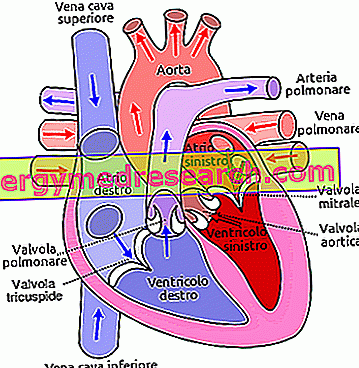The heart has four valves, called heart valves. Their function is to ensure that during the cardiac cycle the flow of blood into the heart proceeds in one direction, the one established by the pressure gradient.
The heart valves are:
- Two atrioventricular valves (AV): mitral valve and tricuspid valve, placed between atria and ventricles
- Two semi-lunar valves (SL): aortic valve and pulmonary valve, placed between the ventricles and arteries

The valves are made of thin but very resistant membranes, which open and close at each heartbeat in a coordinated manner, normally allowing the flow of blood to move in only one direction through the heart, preventing reflux (or retrograde flow) .
From a structural point of view, heart valves separate:
- heart chambers (atria and ventricles) (AV valves);
- aorta and pulmonary artery from the ventricles (SL valves).
Atrioventricular valves
The atrioventricular valves (AV) separate the atria from the ventricles, allowing blood to flow unidirectionally from the atrium to the ventricle (preventing it from flowing backwards), opening and closing in relation to the cyclical changes that occur at each heartbeat:
- open AV valves: the pressure in the atrium is higher than that of the ventricle;
- closed AV valves: the ventricular pressure is higher than the atrial one.
The closure of the valve corresponds to the first heart tone and corresponds to the beginning of the systolic phase.
The atrioventricular valves consist of a muscular component and a fibrous one.
- Mitral valve (or bicuspid) : located between the atrium and left ventricle, consisting of two flaps (or cusps) and a valve ring that connects the cusps to the heart wall. Connective tissue filaments (tendinous cords) connect the free margins of the valve leaflets to the cardiac muscle, in particular to the papillary muscles, which give stability to the tendinous cords. CURIOSITY: the mitral term derives from the similarity with the miter, the high headgear worn by the bishops.
- Tricuspid valve: atrioventricular valve with three cusps, separating the right atrium from the right ventricle. As for the bicuspid valve, the correct functioning of the tricuspid involves the interaction between the valvular ring, tendon cords, papillary muscles and right ventricle.
NOTE: neither the papillary muscles nor the tendon cords are able to actively open and close the atrioventricular valves. The valves, in fact, open and close PASSIVELY based on the thrust of the blood flow.
When the ventricle contracts, the pressure imparted to the blood against the lower face of the flaps of the AV valve forcefully pushes them upwards into the closed position; the tendinous cords prevent this blood pressure from pushing the valve into the atrium. When the tendinous chords are not able to oppose a sufficient opposition, the AV valves are pushed backwards, towards the interior of the atrium, during the ventricular systole (contraction); in this case we speak of PROLASSO valvolare.
Semi-lunar valves
The semi-lunar valves are located at the point of passage between the ventricles and the large arteries. Their function is similar to that of the AV valves: they allow the blood to flow in the correct sense, preventing the inverse movement (from the arteries to the ventricles). The semi-lunar valves, each formed by three cusps, open when the ventricular pressure exceeds the arterial pressure downstream: blood can thus leave the ventricles and enter the arteries. The valves close when the ventricles release and the ventricular pressure becomes lower than the arterial pressure; in such circumstances the sague, trying to flow backwards, fills the valve flaps closing them with a click. The valves have a characteristic swallow's nest structure (the edges fit into a ring of fabric, with a typical "cup-shaped" shape). The aortic valve and the pulmonary valve have three cusps and their staggered position ensures the closure of the vessel preventing blood from refluxing into the ventricle. These valves do not have tendinous cords.
- Semi-lunar aortic valve: located between the left ventricle and the aorta. During ventricular systole, pressure increases in the left ventricle. When the pressure in the left ventricle exceeds the pressure in the aorta, the aortic valve opens, allowing the blood to exit the left ventricle and flow into the aorta. When the ventricular systole ends, the pressure in the left ventricle decreases rapidly → When the pressure decreases in the left ventricle, the aortic pressure forces the aortic valve to close. The closure of the aortic valve corresponds to the second heart tone.
- Semi-lunar pulmonary valve : it is located between the right ventricle and the pulmonary trunk (pulmonary artery, which conducts oxygen-poor blood to the lung).



